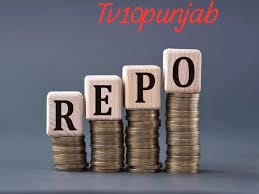Sandeep Dhand
Journalist and Research Analysist
The Repo Rate (short for Repurchase Rate) is the interest rate at which the Reserve Bank of India (RBI) lends money to commercial banks for short periods, usually overnight. In simple terms, it is the rate at which banks borrow money from RBI when they face a shortage of funds.

Banks take loans from RBI by selling government securities with a promise to repurchase them later. That’s why it’s called a “repurchase” rate.
Who Decides the Repo Rate?
The Monetary Policy Committee (MPC) of the RBI decides the repo rate. This committee meets every two months (6 times a year) to review the economy and decide whether to:
Increase the repo rate
Decrease the repo rate
Keep it unchanged
How is Repo Rate Decided?
The repo rate is decided based on several key economic factors, including:
- Inflation – If inflation (rise in prices) is high, RBI may increase the repo rate to reduce spending and borrowing.
- Economic Growth – If growth is slow, RBI may reduce the repo rate to encourage borrowing, investment, and spending.
- Liquidity in the Market – If there is too much money in circulation, RBI may increase the rate to reduce it.
- Global Economic Conditions – RBI also looks at global oil prices, U.S. Federal Reserve policy, and other international trends.
- Fiscal Deficit and Currency Strength – To manage the value of the Indian Rupee and balance government spending.
Why Repo Rate is Increased or Decreased?
Repo Rate Increase:
RBI increases the repo rate to control inflation. Higher repo rates make loans expensive, so people and businesses borrow less. This reduces spending and helps control rising prices.
Repo Rate Decrease:
RBI lowers the repo rate to boost the economy. Cheaper loans mean more borrowing, more investment, and more spending. This helps create jobs and boost demand.
Example: June 2025 Rate Cut
Suppose the RBI reduces the repo rate in June 2025. It likely means inflation is under control and the RBI wants to boost growth.
Benefits of Repo Rate Cut
- Lower Loan EMIs – Banks may reduce interest rates on home, car, and personal loans. This lowers EMIs (monthly payments).
- Boost in Spending – People borrow and spend more, which helps businesses grow.
- Encourages Investment – Companies can take cheaper loans to expand and hire more employees.
- Stock Market Positivity – Lower rates often increase investor confidence, which may boost the stock market.
Who Benefits the Most?
Home loan and personal loan borrowers
Businesses looking to expand
Real estate and automobile sectors
Stock market investors
Who May Face Challenges?
Fixed deposit investors – Lower repo rates may lead to lower FD interest rates.
Banks – May earn slightly less on loans compared to higher-rate periods.
Conclusion
The repo rate is one of the most important tools RBI uses to manage the Indian economy. A cut in repo rate is usually good news for borrowers and businesses, while an increase is a sign that RBI is trying to control inflation. Every change in repo rate impacts daily life — from your loan EMIs to the price of goods and services.